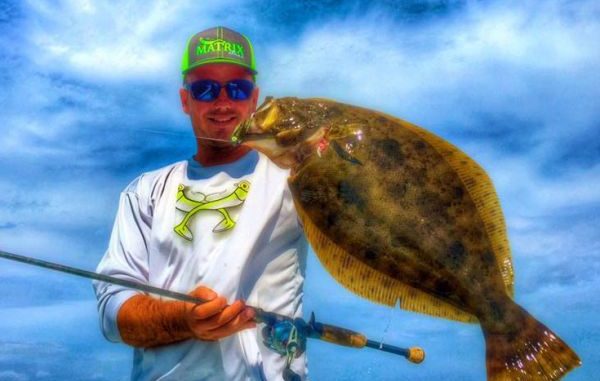
It’s almost time for annual run on Trestles, Rigolets Pass and Chef Pass, Champagne says
Long before the “World Series Trout Run” takes place in October, another tasty species usually kicks off fall fishing fever for Lake Pontchartrain anglers.
Big flounder head offshore about this time each year to spawn, and the Trestles, Rigolets Pass and Chef Pass are three spots where waves of doormats typically congregate on their way to the Gulf.
Chas Champagne, owner of Matrix Shad and Vortex Shad soft plastic paddle tail lures, shared some great tips to try if you want to catch more flounder this fall.
1. Maintain contact with the bottom.
“When I’m flounder fishing, I’m just kind of dribbling it,” Champagne said. “I’m not trying to lift it too high. They’re dug down in that mud.”
To get to the bottom, Champagne typically uses a ⅜-ounce Goldeneye jighead, paired with either a green hornet or avocado Matrix Shad or a blazin’ hornet Vortex Shad tipped with a piece of dead shrimp. He’s also a fan of the Berkley Gulp in new penny shrimp or white.
“Flounder are pretty aggressive, and they’re really greedy,” he said. “If you’re fishing and you miss one, immediately throw it right back in the same spot. You could have actually had him hooked, and he’ll bite it again — they’re really weird about that.”
On the Trestles, Champagne works on and around the pilings where big flounder lurk and ambush their prey.
“For some reason, they always want to be on the west side of the Trestles toward the North Shore,” he said. “Every time I’ve seen a good migration that’s where it is. I don’t know if it’s sandier or muddier, but there’s something about that side they favor.
“And it doesn’t matter if the tide is falling or coming in — they want that side.”
In Rigolets Pass, Champagne works the banks, preferably on a falling tide.
“Get up on the bank and pitch it all the way up to the grass and just dribble it off,” he said. “Those passes will start out at 10 inches of water when you drag it out some, and then you’re in 2 feet of water and you drag it out some to 4 feet of water, and then boom — you have a canyon where it drops off to 20 feet.
“Most of the time they’re up on that flat, but sometimes they’re on the side of that big ledge and they thump it on the way down.”
That’s where a ⅜-ounce jighead comes in handy, he said.
“When I come off that canyon, I can still make contact with the bottom one more time,” he said. “I also have a lot of friends that fish spinnerbaits in the shallower areas. They’ll just slow roll a spinnerbait, and the flounder really like that.”
2. Tip your lures with strips of flounder belly skin.
“If I catch a flounder right out the gate, I’ll sit there and cut little pork rind strips — like a quarter-inch wide by 1-inch long — off the white part of his belly,” Champagne said. “It’s the same concept as a piece of old shrimp. That belly skin is so tough, you can catch like four or five flounder on the same piece.
“It just gives it a little added scent. An old-timer showed me that years ago, and I remember that day he out-fished me like 12 to two on flounder.”
To see a video of Champagne using this technique, click here.
3. Set the hook — hard.
“If you are really taking it serious, I would use a medium-heavy rod — that way when you set hook you are driving that hook and penetrating their mouth,” Champagne said. “Their mouths are brutal. Sometimes when I land a fish, it’s like they get lockjaw. I can’t even open his mouth, and I just end up cutting the line.
“Their mouths are so powerful, it’s unbelievable. You don’t want to get your fingers caught in there.”
Many times, he said the fish will chomp down on a lure without getting hooked, but end up being caught because they refuse to let go.
“Most of the time they’ll see the boat and let it go right there at the boat,” he said. “But I can’t tell you how many times I’ve landed flounder when they’ve never had the hook in their mouth. That’s how strong their mouths are.”
Champagne said the last really serious flounder run in the lake was in 2012, and he’s hoping for more doormats in the 2- to 7-pound range starting next month and lasting into November.
“When it’s right, it’ll be like a 3 ½ pound average,” he said. “It’s the best I’ve ever seen in my life.”


